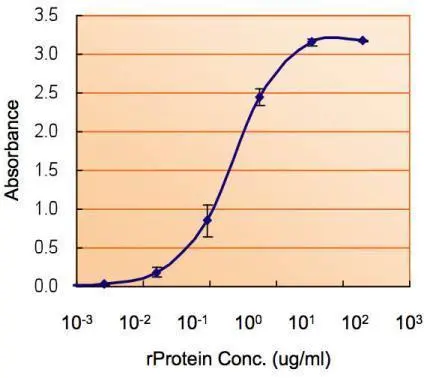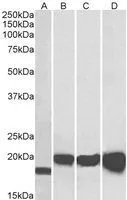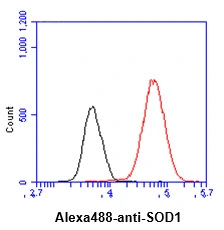
ELISA detection of SOD1 using GTX100554 for capture at a concentration of 5 microg/mL and GTX89049 for detection at a concentration of 1.5 microg/mL. The HRP-conjugated anti-goat IgG antibody (GTX26741) was diluted at 1:20,000-1:200,000 and used to detect the primary antibody.
SOD1 ELISA Pair
GTX500010
ApplicationsELISA
Product group Antibodies
ReactivityHuman, Mouse, Rat
TargetSOD1
Overview
- SupplierGeneTex
- Product NameSOD1 ELISA Pair
- Delivery Days Customer9
- Application Supplier NoteWe recommend using the capture antibody at a concentration of 5microg/mL and the detection antibody at a concentration of 1.5microg/mL. Optimal dilutions should be determined experimentally by the researcher.
- ApplicationsELISA
- CertificationResearch Use Only
- Gene ID6647
- Target nameSOD1
- Target descriptionsuperoxide dismutase 1
- Target synonymsALS, ALS1, HEL-S-44, IPOA, SOD, STAHP, hSod1, homodimer, superoxide dismutase [Cu-Zn], Cu/Zn superoxide dismutase, SOD, soluble, epididymis secretory protein Li 44, indophenoloxidase A, superoxide dismutase 1, soluble, superoxide dismutase, cystolic
- Scientific DescriptionThe protein encoded by this gene binds copper and zinc ions and is one of two isozymes responsible for destroying free superoxide radicals in the body. The encoded isozyme is a soluble cytoplasmic protein, acting as a homodimer to convert naturally-occuring but harmful superoxide radicals to molecular oxygen and hydrogen peroxide. The other isozyme is a mitochondrial protein. Mutations in this gene have been implicated as causes of familial amyotrophic lateral sclerosis. Rare transcript variants have been reported for this gene. [provided by RefSeq]
- ReactivityHuman, Mouse, Rat
- Storage Instruction-20°C or -80°C,2°C to 8°C
- UNSPSC12352203



![FACS analysis of A431 cells using GTX83012 SOD1 antibody [6F5]. Green : SOD1 Purple : negative control](https://www.genetex.com/upload/website/prouct_img/normal/GTX83012/GTX83012_20170912_FACS_w_23061322_639.webp)
![IHC-P analysis of human breast adenocarcinoma tissue using GTX83592 SOD1 antibody [8B10]. Antigen retrieval : Heat-induced epitope retrieval by 10mM citrate buffer, pH6.0, 100oC for 10min.](https://www.genetex.com/upload/website/prouct_img/normal/GTX83592/GTX83592_1620_IHC-P_w_23061420_174.webp)
![ICC/IF analysis of Flag-tagged SOD1 wild type or G93A mutant-expressing HEK293 cells using GTX57211 SOD1 (mutant) antibody [MS785], GTX57212 SOD1 (mutant) antibody [MS27] or MS785/MS27 cocktail. Fixation : 4% PFA for 10 min at RT. Permeabilization : 0.2% Triton X-100 for 5 min Dilution : 1microg/ml (12 hours at 4oC)](https://www.genetex.com/upload/website/prouct_img/normal/GTX57211/GTX57211_GTX57211_ICC_IF_1-1_w_23061123_271.webp)
![ICC/IF analysis of Flag-tagged SOD1 wild type or G93A mutant-expressing HEK293 cells using GTX57211 SOD1 (mutant) antibody [MS785], GTX57212 SOD1 (mutant) antibody [MS27] or MS785/MS27 cocktail. Fixation : 4% PFA for 10 min at RT. Permeabilization : 0.2% Triton X-100 for 5 min Dilution : 1microg/ml (12 hours at 4oC)](https://www.genetex.com/upload/website/prouct_img/normal/GTX57212/GTX57212_GTX57212_ICC_IF_1-1_w_23061123_734.webp)

